The Modern Age of Mobile DSPs
By Director of Growth, Yotam Galon
“It’s not about good or bad platforms or promoting DSPs versus Facebook, Google, or self-serve ad networks. It’s about how advertisers can cover the countless impressions around the world in the best way possible through insights and data rather than guesses and promises.”
The Modern Age of Mobile DSPs

By Director of Growth,
Yotam Galon
Digital advertising has evolved immensely over the past two decades. A complex and dynamic field—in which every activity involves a number of moving parts—digital advertising has finally reached a stage where advertisers have access to better tools for promoting their product, growing, and improving their company and portfolio.
In this paper, we’ll highlight the crucial features that advertisers today must look for in the mobile DSPs (demand-side platforms) they are using, and how their choice of DSP can impact their overall growth and success.
Mobile demand-side platform (DSP) is the software used by mobile advertisers to buy advertising from multiple ad sources. Below you’ll learn everything you need to know about mobile DSPs.
Many advertisers are under the impression that Facebook and Google are the largest and best platforms available for mobile advertising. While these platforms have their advantages, they overlook a significant chunk of high-quality users who are out of their reach. The diagrams below illustrate this split, and the underlying reason why DSPs help advertisers reach this large portion of people and significantly increase their global impressions
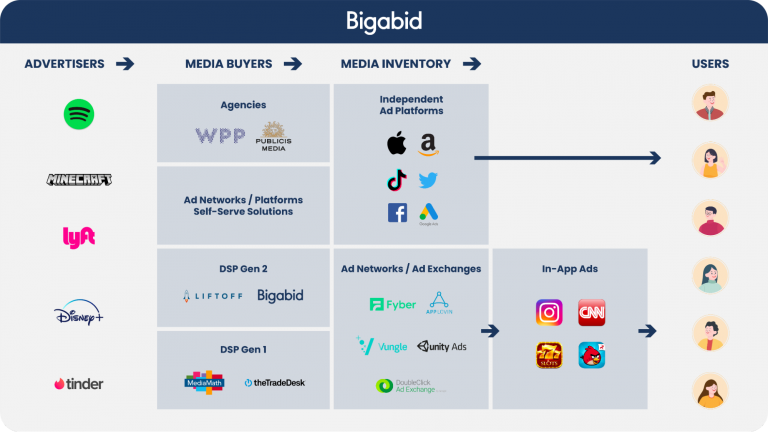
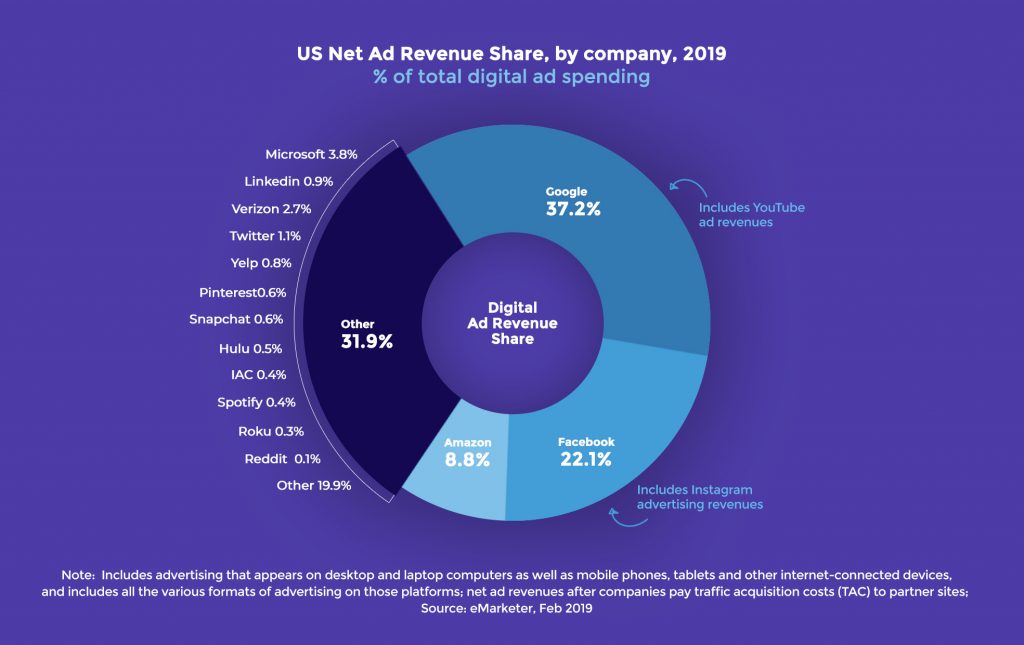
As Google and Facebook became over-saturated and expensive in recent years, more advertisers began looking for other areas to acquire users. This trend led to more companies offering their inventory through their own platforms or other exchanges outside of Google’s and Facebook’s reach. As you can see from the image above, a third of US digital ad revenue in 2019 was already spent outside of Google and Facebook.
Real-Time Bidding
Another important milestone in the evolution of digital advertising is real-time Bidding (RTB). Released in 2009, real-time bidding was developed as a solution for enabling programmatic advertising exchanges to manage their rich and dynamic inventory on an impression basis. RTB quickly became the leading methodology, making irrelevant the previous approach of static auctions that couldn’t keep up with the pace of the evolving mobile market. Then, in 2010, the Interactive Advertising Bureau (IAB) created an official protocol that became an industry standard, one in which all leading exchanges were aligned and selling their ads under the same principles. This protocol is called OpenRTB.
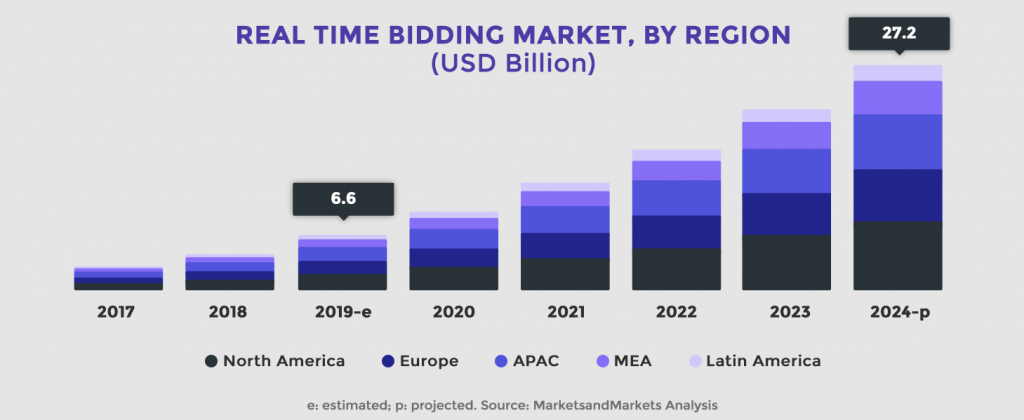
The DSP Role in the Advertising Ecosystem
In today’s global market, there are billions of ad impressions that are being auctioned to the highest bidder simultaneously, with thousands of competitors fighting for each user. These bidders come in many forms and can act in many different ways. But as in many tech industries, the ones with the smarter, faster, and more scalable feature set win. As such, advertisers should constantly look for the best tools so they don’t fall behind. Below is a high-level overview showing the DSP within the digital advertising chain. Note that the number of parts can vary depending on the way the advertiser decides to work as well as the capabilities of each player in the chain
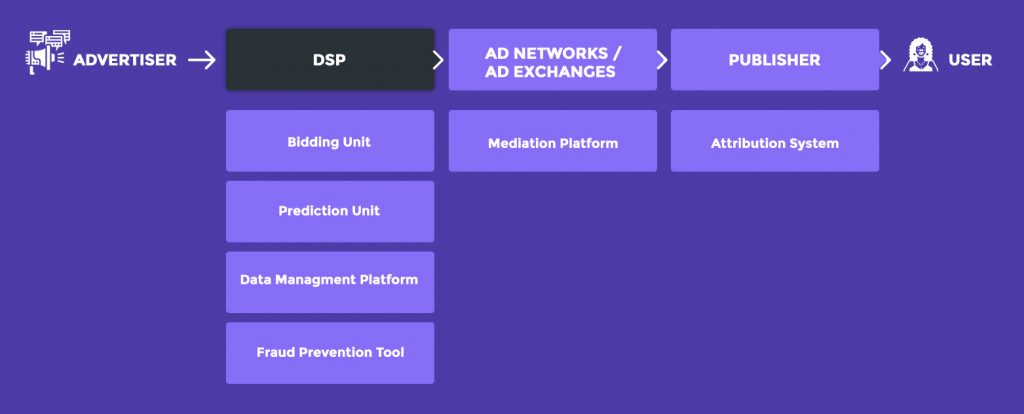
DSP(Demand-Side Platform) Evolution
Before diving into the evolution of DSPs, it’s helpful to really understand the reality advertisers face in the mobile world. The classic game “Where’s Waldo” can help bring this understanding to light. Imagine searching for Waldo against hundreds of other players at the same time. Or, imagine an auction house with hundreds of competitors, and you have only 10 milliseconds to decide if you’re all in. This is the type of environment digital advertisers must navigate—and the one where DSPs make a world of difference.
1st Generation Mobile DSPs
The first DSPs surfaced in the late 2000s when companies like MediaMath and TheTradeDesk began offering advertisers and marketers tools for buying online ads from multiple sources through a single interface. This marked the beginning of a revolutionary era in digital advertising, and the approach was quickly adopted by leading companies around the world.
That this shift took place only in the late 2000s may sound unimaginable. But consider that the first iPhone was released around the same time, in 2007. The mobile app industry was far from mature at this point, as was the mobile advertising industry. So who did the 1st gen DSP target, and why was the demand so high?
The first generation of DSPs, including MediaMath and others, offered brands a unique solution for reaching users across multiple platforms for brand awareness, specific marketing campaigns and more. These solutions enabled companies to bypass the need to bring the tech in-house, while gaining advanced tool sets that drove positive results.
Today, these companies are still thriving and leading some of the largest advertising budgets on the market. While the second generation of DSPs came to life a few years later, it’s important to note that, on some levels, the different generations address different customers and aren’t necessarily inferior from one another. They should (and do) exist in parallel.
From Gen 1 to Gen 2
The main differences between DSP generations revolve around what’s commonly referred to as “performance advertising.” In mobile performance advertising, the DSP’s goal extends beyond getting the app installed. It also involves predicting how probable it is that the user will engage with the app (either via IAP or through watching ads). Other than the focus on performance, the 2nd generation DSP also has the ability to enrich the advertiser through insights that can impact the actual product and not only improve the return on ad spend.
The 2nd generation DSP was created as part of the natural evolution of the mobile app market, along with the understanding that the 1st generation was great for “eyeballs” and non-in-app campaigns, but wasn’t ideal for performance marketers. It was also understood that too many “cooks in the kitchen” is not the ideal way to operate if the mission is fast, efficient, and data-driven advertising.
Slowly, some elite DSPs have decided to bring more and more technologies and knowledge in-house, from bidding units ready for large scale, through data management platforms (DMPs), prediction tools, and even their own fraud and anomaly detection tools. This can be a lengthy, complex, and expensive process. Only a few DSPs to date have managed to create a robust feature set that actually provides the same efficiency and precision as those of various separate platforms. Among the few are Bigabid, Liftoff.io, Aarki, Moloco, with others hopefully on the way.
Core Components for Qualifying as a 2nd Gen DSP
Bidder
The bidder is the beginning and the end of the chain within the DSP, and the only component that communicates with the SSP (supply-side platform). Although it’s the most “basic” component, its sophistication, efficiency and scalability are crucial for the success of the entire flow.
Pro tip: When prospecting potential DSP partners, ask about their bidder capabilities to make sure that the DSP will not fail under pressure or limit your growth. Note that some DSPs offer bidders that were built in-house, while others license a bidder as a SaaS solution from a third-party. The second approach can limit performance; licensed bidders can only be modified to a certain extent, and this can be limiting in terms of scale and visibility. For example, you might find yourself in the scenario where the SaaS bidder doesn’t support the entire data set per bid. Because the bidder is from a third-party, the DSP partner might not be able to modify it as needed.
DMP/AMP
Data management and audience management platforms are the real-time knowledge source of a 2nd generation DSP, updating literally every few seconds. This is where all raw data is sent to from various sources, analyzed, and stored under the highest security standards, standing by to be used in a matter of milliseconds. When combining a DMP and an AMP under the same hood, the effectiveness multiplies as you increase scale, speed, and quality.
Pro tip: Make sure that the majority of your DSP partner’s data is deterministic and not probabilistic, as this will likely have a major effect on quality and therefore on your ROAS.
Machine Learning
This is where a bit of creativity comes into play. Collecting more and more raw data is great, but the real game-changer is what you do with it. In 2nd generation DSPs, the data science team and their ML arsenal form a crucial part of the task force, one that must think like both the end-user and the advertisers concurrently. They will research the best bidding and pricing strategy, user behavior, and journey while also looking at market trends in accordance with business goals, all with the aim of providing the smartest solution possible for predicting the right next moves. As many companies don’t have such capabilities in-house, using the insights provided by the DSP helps advertisers modify their ads, and even their product through app store optimization (ASO), GEO exploration, user journeys, pricing and more. This consequently affects the entire economy of the app, and, in larger companies, helps maintain a healthy cross-studio economy.
Learn more about how Real-Time Data Analysis at scale works.
Traffic sources
In order to be able to maintain the high pace and quality as you grow your advertising budget, you need an inventory that is big enough, and that can support the scale and efficiency you are looking for. 2nd generation DSPs mostly get their traffic from the major ad exchanges including Google Adx, MoPub, UnityAds, Fyber, AppLovin, etc. At times, they also get traffic from direct publishers, as long as they can provide an RTB connection and full transparency. As a rule of thumb, this traffic is less fraudulent, but to remove any doubt, some DSPs will use a combination of internal and external fraud and anomaly detection tools to make sure the activity is legitimate.
Pro tip: Don’t get too excited by promises for low CPMs. Many times, higher CPMs mean more and better traffic and more direct publishers (see diagram below).
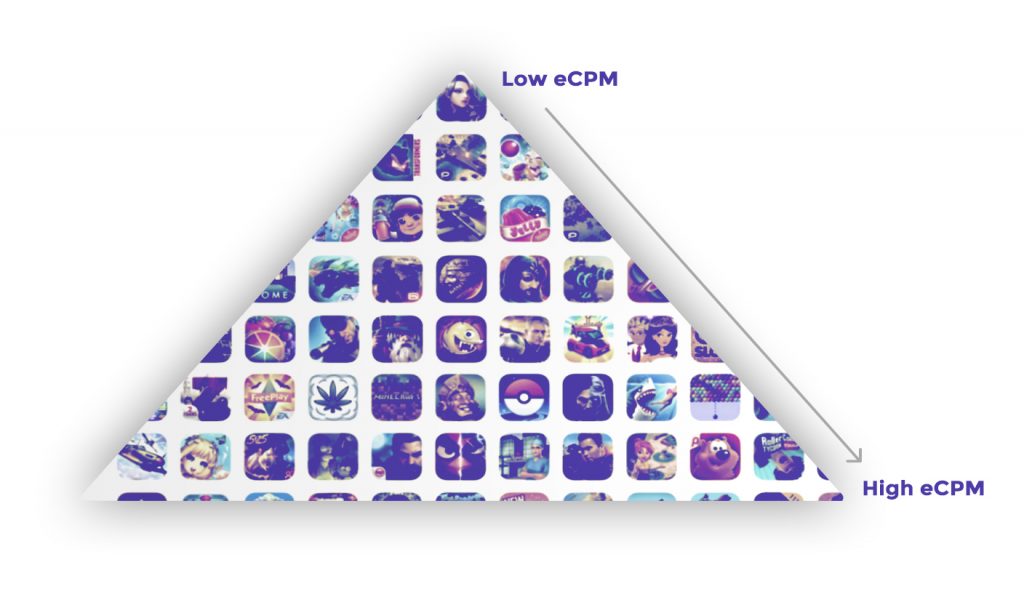
How to identify a real 2nd generation DSP
DSPs that claim to have the components discussed above must do more than merely make claims. Advertisers these days are high-tech people; they are well aware of the resources and struggles involved in developing powerful software products. With this, advertisers should always inspect potential DSP partners very closely and understand whether they actually fulfill their claims .
Here are some tips for evaluating whether or not a 2nd generation DSP can actually provide everything they offer:
Advantages of first-party data & why it’s crucial for performance advertising
Imagine you’re interested in buying a new Toyota Prius. Would you rather hear reviews from a thousand people who drive any car, or fifty people who drive a Toyota Prius? Would you also prefer to make sure these fifty people are driving the latest model that you’re considering?
The bottom line here is that we don’t know what we don’t know. And, we should use what we do know. Advertising is based on probability, and performance advertising needs this probability to be based on the most accurate information available.
Many companies offer their 3rd-party data to be used by DSPs for targeting. This can be great for research and reference purposes, but cannot be the only source. Raw data sounds scary to most, but for savvy machine learning algorithms like the ones in 2nd generation DSPs, this is the fuel that leads to the best results.
When a company withholds data from their DSP partner, they prohibit the DSP’s ability to provide optimal results. Today, more advertisers are opening up to sharing user-level data due to new security standards and attribution systems that make data sharing a smooth process. Moreover, they understand that the DSP is meeting the same security standards as Google and Facebook, with whom they’re also sharing data. Above all, sharing raw data is a basic requirement for accurate targeting.
Discover more about how Bigabid is Targeting High LTV Users.
Transparency is a two-way street
Transparency became a major buzzword in the advertising industry, but only from the platform side; the true power of the platform shines more from mutual transparency.
DSPs are high-end R&D teams that you should use to your advantage (anyway, they are already included in the service!). Let them analyze, let them strategize, give them freedom so they can help develop your product through deep insights based on deterministic data. The more you provide, the better their results. Give them analytics of best and worst practices, events, historical data, demographics, creatives, costs, publishers, exchanges, etc. The more, the merrier! Without this mutual transparency, you as an advertiser will not be able to get the same results in this portion of the market that you get in the portion of Facebook and Google (where mutual transparency is lacking), and it will be a big miss, to say the least.
Read more about Partnering with Transparency with Bigabid.
Security and privacy compliance
Your data is your fortune, and all parties must treat it as such. If, in the past, secured servers and privacy policies were an “extreme measure,” today they are mandatory for every company dealing with and storing data.
Data-driven advertising platforms will often store personal data such as email and location, as well as data on spending habits and sometimes even financial information that is highly sensitive. This data has a major effect on the performance of advertising campaigns, so it can’t be avoided. Instead, DSPs must follow and create even higher standards to maintain data privacy. As a basic requirement that keeps on updating, your partners should be fully IAB, GDPR, and CCPA compliant, and of course, any additional security layer is most welcome.
You know yourself. Your DSP knows everyone
DSPs can learn trends that are relevant to your DNA and vertical from other players in your field. While using data from one advertiser for another is forbidden, learning is allowed and even highly recommended. This opportunity for learning from the DSP’s cross-vertical experience can positively impact your entire app. Even if no names or numbers are shared, be open to suggestions when it comes to your segments, new GEOs, creatives, your user flow and more. After all, you can always listen without implementing.
It’s not about good or bad platforms or promoting DSPs versus Facebook, Google, or self-serve ad networks. It’s about how advertisers can cover the countless impressions around the world in the best way possible through insights and data rather than guesses and promises.
The world’s population is growing exponentially, and along with it, so is the use of mobile devices. Even if the giants’ market share is significantly larger, the relative portion that they can’t reach is also massive, and it shouldn’t be ignored.
Bigabid is among the pioneers bringing order to this segment that was once called the “wild west of advertising,” helping advertisers reach users who are outside the “safe zones” of the Google and Facebook duopoly. We are a 2nd generation DSP with a valid platform that advertisers should test if they want to reach a massive and lucrative global audience. Please click the “contact us” button below to find out more information about mobile DSPs or to get started.